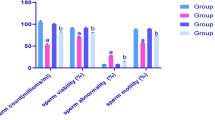Summary
The protective effect of Decapeptyl, a d-Trp6-LHRH analogue, on the germinal epithelium of rats during chemotherapy was examined in an experimental animal study. Four groups were formed consisting of 15 (groups A and B) and 20 (groups C and D) Sprague-Dawley rats, respectively. The animals were treated as follows: group A (control group) was given 0.9% NaCl i.m.; group B (LHRH group) d-Trp6-LHRH analogue (Decapeptyl); group C (LHRH + chemotherapy group) Decapeptyl +_cyclophosphamide; group D (chemotherapy group) cyclophosphamide. The gonads were removed before therapy was initiated and on days 13, 52, and 182 after treatment and examined histologically. In addition, follicle-stimulating hormone (FSH) levels in the serum, a sensitive indicator of tubular damage, were determined. The most damaging effects of chemotherapy on histology and hormone levels were observed in the animals in group C, which were additionally treated with LHRH analogues. Therefore, it is not possible to protect the germinal epithelium of the rat with LHRH analogues during chemotherapy.
Similar content being viewed by others
References
Chapman RM, Sutcliffe SB, Rees LH, Edwards CR, Malpas SJ (1979) Cyclical combination chemotherapy and gonadal function. Retrospective study in males. Lancet I:285
Delbrück H (1985) Zytostatisch bedingte Spätstörungen. Klinikarzt 14:1418
Dowling KJ, Lewis RW, Schally AV (1984) Suppression of spermatogenesis in the non-human primate using a potent LHRH agonist — possible clinical implications. American Urological Association Annual Meeting, May 6–10, New Orleans (Abstract 494)
Fairley KF, Barrie JU, Johnson W (1972) Sterility and testicular atrophy related to cyclophosphamide therapy. Lancet I:568
Glode LM, Robinson J, Gould SF (1981) Protection from cyclophosphamide-induced testicular damage with an analogue of gonadotropin-releasing hormone. Lancet I:1132
Hilscher W (1985) Umwelt und Fertilität. Z Hautkr 60:1040
Hilscher W, Reichelt P (1968) Untersuchungen am Samenepithel der Ratte nach Gaben von “Endoxan” und “Natulan”. Beitr Pathol Anat 137:452
Krause W (1988) Use of buserelin for the protection of spermatogenesis in cytotoxic treatment. In: Höffken K (ed) LH-RH-agonists in oncology. Springer, Berlin Heidelberg New York, p 105
Kreuser ED, Hetzel WD (1988) Reproductive and endocrine gonadal capacity with and without GnRH analogue application during chemotherapy in patients treated for testicular cancer. In: Höffken K (ed) LH-RH agonists in oncology. Springer, Berlin Heidelberg New York, p 111
Lewis RW, Dowling KJ, von Schally A (1985) d-Tryptophan-6-analog of luteinizing hormone-releasing hormone as a protective agent against testicular damage caused by cyclophosphamide in baboons. Proc Natl Acad Sci USA 82:2975
Nseyo UO, Englander LS, Huben RP (1984) Protection of germinal epithelium with LHRH analog. American Urological Association Annual Meeting, May 6–10, New Orleans (Abstract 240)
Propping D (1987) Samenkonservierung als Fertilitätsprophylaxe bei Tumorkranken und erfolgreiche homologe Inseminationsbehandlung. In: Propping D (ed) Fertilitätserhaltung bei Tumorpatienten. Grossc, Berlin, p 33
Sandow J, Beier B (1982) LHRH-agonists: mechanism of action on target tissues. In: Schroder HF, Richards B (eds) Therapeutic principles in metastatic prostatic cancer. Liss, New York (EORT genitourinary group monograph 2, part A)
Schwaiger R, Stief C, Ziegler M (1986) Tierexperimentell Untersuchung zur Verbesserung der Ischämietoleranz des Hodens. Urologe [A] 25:174
Thachil JV, Jewett MAS, Rider WD (1981) The effects of cancer and cancer therapy on male fertility. J Urol 126:141
Wagner FOT (1986) Neue diagnostische und therapeutische Möglichkeiten bei Störungen der männlichen Pubertät und Fertilität. Int Welt 9:313
Weinbauer GF, Nieschlag E (1988) Reversibility of GnRH-agonist-induced inhibition of testicular function: comparison between rat, monkey and man. In: Höffken K (ed) LH-RH-agonists in oncology. Springer, Berlin Heidelberg New York, p 91
Author information
Authors and Affiliations
Rights and permissions
About this article
Cite this article
Papadopoulos, I. LHRH analogues do not protect the germinal epithelium during chemotherapy. Urol. Res. 19, 31–34 (1991). https://doi.org/10.1007/BF00294018
Accepted:
Issue Date:
DOI: https://doi.org/10.1007/BF00294018




